|
Copyright © 2005 David Silver. THE 1939 RIKEN GOKOKU NO. 1 A RARE "LEICA CLONE" FOR #127 ROLL FILM! by David Silver 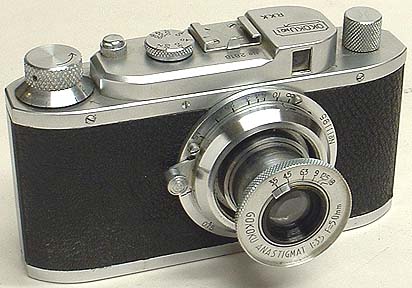 The rare 1939 Gokoku No. 1 from Riken; it looks like a 35mm camera, but it isn't! Starting in the late 1930's, camera manufacturers in Japan faced nearly a decade of hardships and limitations that forced them to adapt a novel approach to the growing popularity of 35mm technology and miniaturization. Substituting more readily available #127 roll film in the place of 35mm, they introduced a number of clever new camera designs that offered the benefits of a significantly larger image size while maintaining the overall dimensions of typical 35mm products. However, several of the manufacturers went a step further, they deliberately copied the famous physiques of the classic Leica and Contax 35mm cameras of Germany, and initiated a brief technological movement that was unique and indigenous to Japan. The Riken Optical Company was a major player during this period of #127 experimentation, and their Gokoku No. 1 remains one of Japan's most rare and ingenious developments. From about 1937 through the end of World War II, the Japanese military placed an inordinate strain on their national photographic industry. In particular, stores of 35mm film and cassettes, and important materials such as certain textiles and fabrics, were routinely diverted to the expanding war effort. Despite the initial success of professional quality 35mm Japanese cameras like the Canon and Leotax prior to the escalation of military operations, the manufacturers soon realized they would have to adapt a different strategy to remain competitive within their resource strapped market. Furthermore, since the government regularly expropriated the best film stocks, the camera firms needed to offer a larger practical format size that would guarantee a reasonably effective image on contact sheets for their customers. There were already numerous compact camera lines established in Japan for #120 and #127 roll film, and they all produced image sizes substantially larger than 35mm, but the vast majority were of the traditional folding bellows variety. Once again, the military monopolized many of the materials typically required in bellows production, folding cameras were no longer practical, so a new manufacturing approach was needed for the public sector. The companies initially responded by taking traditional "semi" and "vest pocket" folding camera designs and preserving their desirable compactness by replacing the bellows section with collapsible or telescoping tubes supporting the lens and shutter. This was the beginning of such popular #127 roll film lines as the Lyrax, the Gelto, and many others. These were mostly chunky little cameras that superficially resembled amateur snapshot 35mm models, and some of them offered short-based coupled rangefinders for more precise focusing, but they lacked the style and sense of sophistication of the Leica-inspired Canon or Leotax. Therefore, hoping to achieve a higher profile with their #127 roll film models, several Japanese manufacturers eventually sought to embrace the success of those Leica-inspired 35mm products by creating their own stylish "Leica clones" specifically for the larger #127 format. 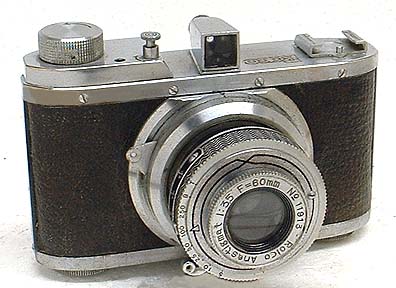 The 1940 Roico, a much more typical and recognizable 4 x 4 format #127 roll film camera from Riken. By 1939 Japan's Riken Optical Company was already familiar with the production of compact collapsible #127 cameras through their purchase of the Olympic Camera Works and subsequent establishment of the Asahi Optical Works (no relation to the Asahi firm that made Pentax cameras) several years before. The latter companies, merged and expanded under Riken's ownership, were responsible for early forays into generic compact #127 designs such as the Vest Olympic and New Olympic "vest pocket" cameras of 1938. They also produced a "semi" size compact camera for #120 roll film with the Semi Olympic of 1937. There would be other standard chunky body models to follow, but Riken was fully aware of the attractive sophistication of the German Leica and Contax 35mm cameras, and a landmark new Riken design was inevitable. Thus the Gokoku No. 1 of 1939 was Riken's initial entry into Japan's unique #127 roll film "Leica clone" camera genre. It was distinctly longer and sleeker than traditional compact #127 cameras, and it bore a strong intentional resemblance to the classic Leica 35mm cameras of its time, as well as Japan's own Canon and Leotax. Two distinct variations of the Gokoku No. 1 were offered. Although they were externally and mechanically identical in almost every way, one was fitted with a fixed lens while the other allowed interchangeability via the Leica 39mm screw mount. The fine example of Gokoku No. 1 from my collection, used here for illustration in this article, is of the fixed lens variety and wears serial #2818. Although the figures are difficult to verify, based on a most likely starting number of #1000, certainly fewer than 2500 were produced, and potentially less than 2000. Since the majority were either lost or abandoned by the end of the war, it is clearly evident that the Gokoku is a very rare camera today. Furthermore, fixed lens models appear to outnumber interchangeable lens versions by about two to one. Typical of any of the better Leica-inspired designs, the Gokoku No.1 is all high quality satin chrome finish, plated over a brass chassis, with black leatherette covered mid section. Its overall appearance is indeed modern and sophisticated with long graceful lines. Of special note is the enormous stylized "G" on top of the camera that wraps around the rest of the Gokoku name. It would be easy to believe this camera's name was Okoku rather than Gokoku if this intended artistic effect was misunderstood! (Editorial note: after this article was submitted, a Gokoku was indeed misrepresented as an "Okoku" on eBay, where it still sold for $1425!) 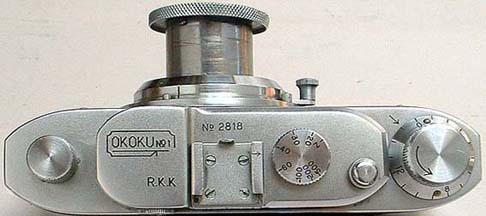 Top view of the Gokoku, showing the controls and the stylized engraving of the name. The Gokoku took up to sixteen 3 x 4 cm exposures on a standard roll of #127 film. Although the camera was only slightly taller and effectively the same length as most comparably styled professional 35mm models, the image area was approximately 38% greater than a full 35mm frame. Unlike its 35mm predecessors, the Gokoku was quite simple to load. After removing the one-piece back and base plate, the empty supply spool was switched from the supply chamber to the take-up chamber, a new roll was dropped into the supply side, and the film's paper leader could be pulled across the focal plane and attached to the take-up spool. With the back closed again, the film was advanced until the first exposure number was seen in the rear red window. The exposure counter around the film advance knob was then manually set to 0. When the photographer was ready to shoot, the knob was advanced one more time to cock the shutter and bring the counter to 1, and the remaining exposures were indexed automatically after that. A feature most peculiar to the Gokoku is the presence of a rewind knob. Since roll film is normally advanced all the way from one spool to another, a rewind knob would be superfluous. One theory is that the knob is merely a vestigial feature, perhaps suggesting that an original design called for 35mm film until the engineers realized they would need to convert to #127 instead. Too many camera bodies may have been manufactured before the modification to #127 was mandated, and it was economically expedient to simply leave the knobs there. Such a theory makes sense when we see that the feature was eliminated in the camera's later incarnation. On the other hand, the rewind knob gives the camera an even greater resemblance to the classic Leica. Indeed, I've seen incorrect references to the Gokoku as a 35mm camera based solely on people noting the "obvious" function of that knob! 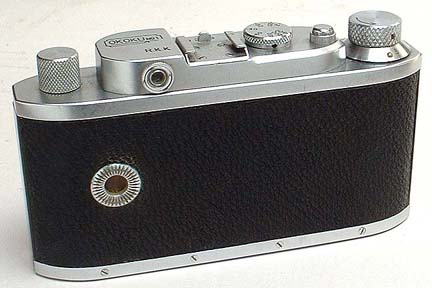 Rear view of the Gokoku, showing the red window for setting the roll film, but note the superfluous rewind knob on top! The mechanical heart of the Gokoku is a traditional horizontal cloth curtain focal plane shutter. The range of shutter speeds available on the top dial includes 1/20, 1/30, 1/40, 1/60, 1/100, 1/200, 1/500, and Z. The optical soul of the camera is the Gokoku 50mm f3.5 lens. In keeping with the Leica-inspired motif, the lens is a striking copy of the Elmar 50mm f3.5 with its nicely knurled front edge, collapsible polished chrome barrel, and tight little aperture control tucked around the front element. The lens on my example has an early "European" aperture progression of f3.5, f4.5, f6.3, f9, f12.5, and f18. However, there are also examples of the Gokoku lens with the "modern" aperture progression of f3.5, f4.5, f5.6, f8, f11, f16, and f22. The lens most frequently associated with the interchangeable mount versions of the Gokoku No. 1 is the Ofunar 50mm f3.5, also a stunning clone of the Elmar with the early aperture progression, and quite a rare piece in its own right. Although there is no coupled rangefinder to assist focusing on the Gokoku No. 1, the optical viewfinder is large and bright, and the greater format area with #127 roll film probably went far to alleviate the necessity for precision focus in most situations. Also, the Gokoku and Ofunar lenses offered well-marked and scaled focal distances around their impressively long focusing rotation. However, if photographers were so inclined, they could purchase an accessory rangefinder from Riken to fit in the shoe on top of the camera. 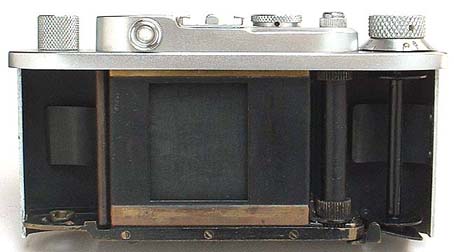 Internal view of the Gokoku, showing the focal plane shutter. The Gokoku No. 1 was a finely made machine, although basically simple in its scope and operation, and its quality is still noteworthy over 60 years later. Despite its initial success, and the obvious integrity of the design as evidenced by the large percentage of existing examples that still function properly, a Gokoku No. 2 was never produced. In its place in 1941, Riken introduced a strikingly similar camera called the Ricohl. The primary differences between the Gokoku and the Ricohl were mostly cosmetic. Where the Gokoku wore a two-piece chrome-plated top with a separate stepped section housing the viewfinder, and supporting the shutter speed dial and accessory shoe, the Ricohl had a more streamlined one-piece top section. The Ricohl also eliminated the vestigial rewind knob, but lost some of its "Leica clone" charm in the process. Otherwise, the cameras were identical in every other way. 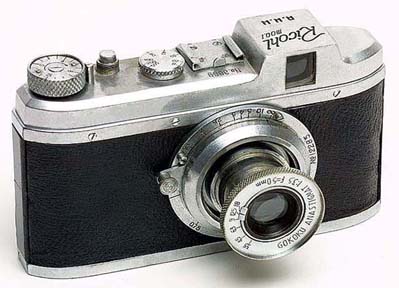 The Ricohl Model I introduced by Riken to replace the Gokoku in 1941. As with the Gokoku, the Ricohl came in fixed lens and interchangeable lens versions, but the former was designated the Model I and the latter the Model II. Subtle variations of the Ricohl remained available throughout the war, and production numbers eventually surpassed the Gokoku by a few hundred. Although both cameras are deservedly considered rare today, only the Ricohl has gained the distinction and sufficient history of verifiable transactions to qualify it for entry in McKeown's Price Guide, and with an understandably hefty appraisal. On the other hand, so little has been written or recorded about the mysterious Gokoku, at least until this article, that it has yet to be entered, but there is no doubt that it entertains a similarly high valuation. When 35mm film became accessible again in Japan after the war, the Leica-inspired #127 roll film cameras were immediately retired and replaced by a wave of fresh new 35mm designs. Ironically, many of the chunky simpler little #127 models survived for a surprising number of years, although they inevitably succumbed as well. Along with Canon, Olympus, Minolta, and a bold newcomer named Nikon, Riken quickly joined the 35mm revolution. History accurately records that only a few of the #127 "Leica clones" successfully reached the public market during World War II, and timidly suggests that their influence was as inconsequential as their brief and unique tenure in the evolution of Japanese photographic technology. I believe, however, that they epitomized a remarkable period of adaptability and ingenuity for those war torn camera manufacturers and engineers. In particular, Riken's Gokoku No. 1 was perhaps their proudest achievement in a time of loss and doubt and diminished capacity, and it remains today one the finest and most desirable examples of Japan's photographic industrial integrity. 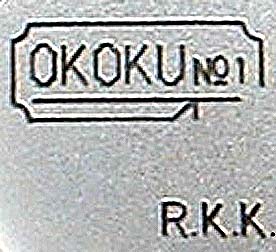 Remember, don't confuse your Riken Gokoku for an "Okoku"! Copyright © 2005 David Silver. All rights reserved. This article first appeared, in slightly edited form, in the April 2005 (issue #154) Camera Shopper magazine. If you'd like to reprint the article, acquire secondary rights, or inquire on the availability of new articles, please feel free to contact the author at silver@well.com, thank you! BACK to the International Photographic Historical Organization article page! GO TO the International Photographic Historical Organization home page! CONTACT the author, David Silver, for more information! |